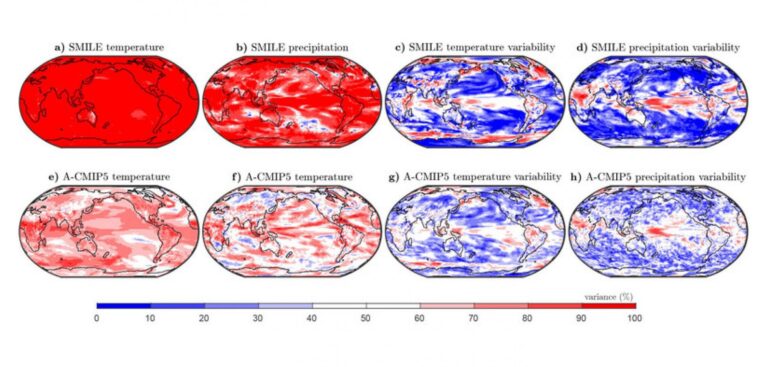The Max Planck Institute for Meteorology in Hamburg, Germany, reports that a new study by two of its scientists – Dr Nicola Maher and Prof. Jochem Marotzke, in collaboration with Prof. Scott Power from Monash University (Melbourne, Australia) – has more accurately quantified model-to-model agreement in strongly forced long-term projections of temperature, precipitation, and their temporal variability.
The research quantified the relative roles of model-to-model differences and internal variability in causing uncertainty in climate model projections. The findings showed that uncertainty across the globe in long-term projections of temperature and precipitation is dominated by model-to-model differences, but that this is not true for temporal temperature and precipitation variability.
When assessing model-to-model agreement, the study identified differences in the forced response to external forcing across the land surface, and found that although all models show warming under a strong forcing scenario, the magnitude of that warming varies by 4°C over Europe, Australia and Asia and 10°C over the Arctic.
The research notes that individual simulations of climate models differ when exposed to external forcing, such as that from increasing greenhouse gases, due to both structural differences between the models and their phase of chaotic internal climate variability. Which of the two causes is at work matters a great deal. If it is the structural differences, model-to-model agreement might increase in the future causing the uncertainty in the response to external forcing to decrease. If, however, it is the internal variability, the spread in projections will not decrease.
In the study, Maher and her co-authors use a new set of six largely independent single model initial-condition large ensembles (SMILEs) to separate the uncertainties due to internal variability and model differences for temperature, precipitation and their temporal variability. By using SMILEs they can easily quantify both the externally forced response in each model (ensemble mean) and its internal variability (the spread of ensemble members). They additionally implement a new method for a multi-model ensemble (CMIP5), where they create small sub-ensembles of models that share an atmospheric component, which are hence not independent.
They found that the uncertainty in temperature and precipitation projections is dominated by model-to-model differences. However, for the temporal variability of both quantities, the uncertainty due to internal variability is generally larger than model differences in the extra-tropics. This has an important implication – that increasing model-to-model agreement in this region for these quantities may not improve the spread of projections.
Maher and her co-authors then studied whether climate models agree not only on the sign, but also on the magnitude of the forced response in the projections. For the simple example of mean-state temperature they confirm that there is model agreement that it will warm everywhere except the northern North Atlantic and the Southern Ocean in both the SMILEs and the CMIP5 sub-ensembles.
When focusing on the magnitude of the change in specific regions in the SMILEs, the study authors found that over Europe, Australia and Southeast Asia the projections disagree by up to 4°C, while over the Arctic this disagreement is up to 10°C. This difference in magnitude can now be quantified much more accurately using the SMILEs and is assessed for precipitation, and temporal temperature and precipitation variability as well as temperature, for three areas that are policy relevant.
The full paper can be found here.



